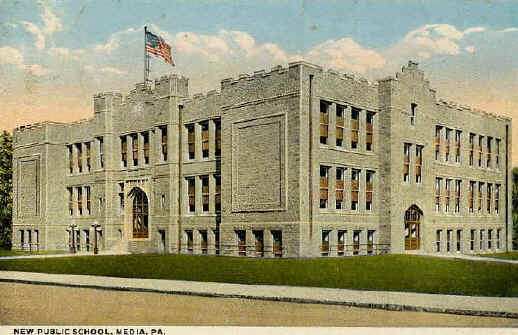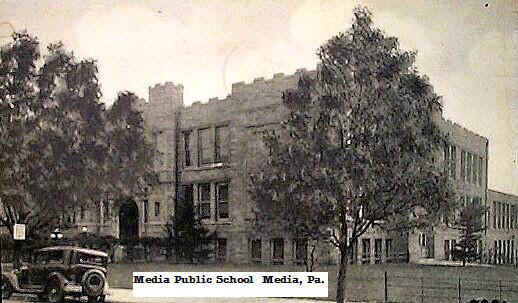Old
CHESTER
in Delaware County, PA
OldChesterPa.com: Media High School
On the
web since March 2000!
Always check our
"What's
New" page
Have you signed our Guest Book at "The Newsstand"?
![]()
A project of the National Heritage Foundation
What is this Foundation?
I'd
like to make a donation to help support this website!
Home > Schools > Neighboring Communities > Media > Media High School
FEATURED PICTURE
Would you like to sponsor this page?
|
Contacting me: - Update I
have temporarily cleared a small amount of space in my email box.
However, spam continues to be a problem. To be sure you get through the
filters, be sure to include the name of our city somewhere either
in the subject or the body of your email. Sponsor |
SEARCH the website - Thousands of pages of Chester History!


Photos courtesy of Harvey S. Martin, Parkside, PA
Principals | Faculty | Staff | Sports | Classes | School History
Alma Mater
All Hail Media High School -
Thy colors white and blue.
Stand as a symbol -
Of Loyalty to you.
Here's honor, truth and courage -
In all we strive to do.
Hail Alma Mater -
Hail to the White and Blue.
| Principals: |
|
||
| Faculty: | Some Teachers: Please see the class lists below for faculty. |
||
| Staff: | |||
| Sports: | Some Coaches/Athletic
Directors: |
||
| Classes: |
Some graduates of Media High School: William Henry Ridley, 1887 |
||
| School History: |
The following articles are courtesy of Harvey Martin, Class of 1949: From the Delaware County Daily Times -Tuesday, June 7, 1966 The end of Media High, of course, also means the end of a memorable athletic history. And as one of the oldest schools in Delaware County, there have been many glorious moments in Mustang sports. At one time, Media High --which was built on the site of the old Shortledge Academy --drew its students from not only Media, but from the entire central part of the county. Over the years, Media had many brilliant individuals and many fine teams. Just as significantly, many family names have been prominent in Media High sports. The Malseeds, the Moats, Kaufmans, Goldsteins, Hibberds, Fishers, Wades, Mooneys, Randolphs, Sheltons, Burrows and Woods, were families each producing at least several fine athletes. The same was true of the Baldwins, Draymans, Pedens, Sneers, Baughns and Gills. Naturally, at a small school such as Media countless athletes excelled in more than one sport. The greatest all-around athlete was probably Johnny Highfield, who starred in football, basketball, baseball and track in the late 1920s. Another great multi-sport star was Francis Van Zant, a football, basketball and baseball ace in the early 1920s.. Still another during that period was Joe Tuckerman, another brilliant three-sport man. One of the earliest known Media greats was Sid Agnew, a football and baseball
standout around 1915. Later, Penn Fury, Pat Ahern, Warren Humes, Bill Lukens,
Roger Malseed, Paige Moat, Joe Kellerman. Ray Worrall and finally Larry Larson Although in recent years, it has slipped somewhat as an athletic power, Media was a strong Section One entry for many years. Football was a particular strongpoint. Perhaps one of the finest gridiron teams was the 1940 squad which won the county championship under coach Gus Anderson, winning all but one game. Center Jack Messick, later a Little All-American at Delaware University, was an all-county selection from that team. Media's first good football team was the undefeated 1915 squad, which defeated Chester, 19-6, for the Mustang's first Thanksgiving Day victory over the Clippers. The team was captained by Bon Jones, and among the stars were Agnew and Milt Westcott. The school also had excellent teams in the 1926-28 era when Highfield and Johnny Valenti were the big names. Valenti, a giant 270-pound tackle and occasionally a fullback, later playing for Pitt in the Rose Bowl and then the Pittsburgh Steelers in the NFL. Still later under coach George Hansell, Media had another memorable period, never losing to Chester between 1941-45. Greats of that era included backs Hank Smedley, Lew Gerlach and Elwood Pettijohn, tackle Art Levin and center Bill Hassler, a two-time all-Delco selection who went on to further stardom at the University of Pennsylvania. There were many other gridiron standouts over the years, not the least of which were
tiny quarterback Izzy Kaufinan; Jack Sugarman; Buddy Behrends, Milford Baker and
Ron Council. In basketball., Media had several successful teams; most notably the 1931 club which won the Chester Kiwanis Tournament for coach Roy Hoffman. Art English, one of the school's finest cagers, Harrison Schaffner, Junie McLaughlin. Izzy Kaufman and Bill Lukens were members of that team. Earlier, the 1924 team had won the Section One championship, while later, the 1961club reached prominence by winning the Class B Kiwanis title and advancing to the finals of the District One playoffs under Coach Eddie Derrick. Walt Bosler in the early 1900s was a top basketball player of his day. Later standouts included Jack Kelly, Bill Davis, Greg Lanery; Malin, Gerald Mathews, Ollie Baker, Derrick and Spud and Donkey Murray. Modern Mustang cage standouts ranged from Dave Schroeder and Henry (Slick) Lee, one-two in the 1958 Section Two scoring race, to Mike West, Wayne Peden, Tom Short, Jim Malseed, and Doug Randolph. Media had many brilliant baseball teams, beginning with the undefeated team of 1916 on which Agnew was a pitcher. Ahern was a top pitcher on another good team in 1918. The Mustangs grabbed the Section One crown in 1929 and 1930, and then between 1936-38 captured three straight titles behind the Berry brother's battery only to have each crown removed because of various rule infractions. Three of Media's foremost baseball players were Lew Krausse Sr., later a pitcher with the Philadelphia Athletics; Buddy Behrends, who had a brief test with the Phillies as an outfielder; and Spud Murray, currently the New York Yankees' batting practice hurler. Rube Hall was simultaneously a standout outfielder and coach in the early 1910s. After him came such greats as Bucky Green, Bilt Moody, Walt Parmer, Cliff and Carl Mooney. George Wilson, Fats, Pete and Frank Baldwin, Roger, Ivin, Clint and Fran Malseed. Matt Fisher and Carl Iacovella. Perhaps the Mustangs' most celebrated track man was Ted Meredith who later starred at Penn. Snatched from Media by Mercersburg Academy, he became in 1912 the first schoolboy ever picked for a U.S. Olympic team, and set world 440 and 880 records which stood for many years. His 1912 880 time of 1 :25.2 was an incredible feat. There were many other track greats at Media, including those who either held state
records or won state championships such as Bob Burnett in the high jump, Highfield
in the 100, Frank Maule in the mile, Gene Talley in the broad jump, Larson in the
100 and 220, and Valenti, who set a state mark in the shot put in 1929 with an
amazing 51-11 toss. Evans Mickle was one of the Mustangs finest runners,
performing the 440 and 880 in the1920s. He also switched to Mercersburg where he was a member of a
world record relay team. About that time, Howard Spahr was a great all around track
man. Howard Leiper was a track great in 1906. In later years, top Mustang thinclads Naturally, there have been many, many others prominent in Media High sports over the years. The above names constitute only a part of a memorable era. Unfortunately, that era is about to end. Media High School History by Jack Morrison June 1966 was a dark time for Media High School students and alumni. The graduating class that month was the last for the venerable high school, one of Delaware County's oldest. In 1906, the School Board approved an option on the tract at State and Edgemont Streets, now the John K. Barrall Memorial Field. |
||